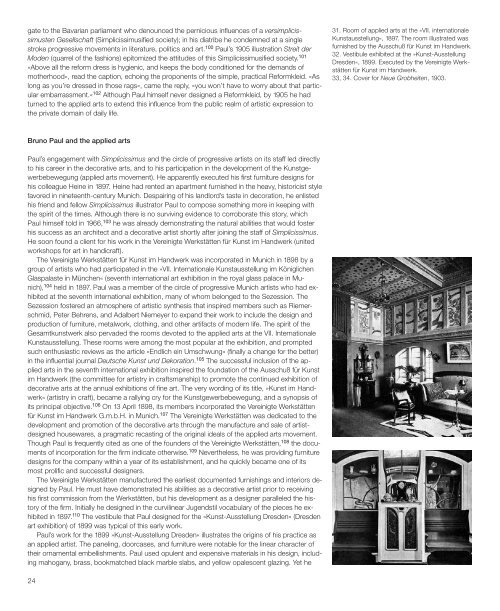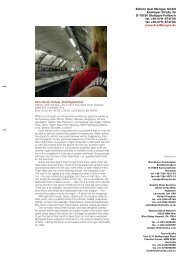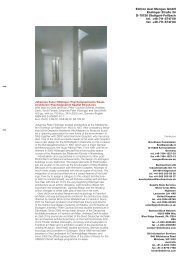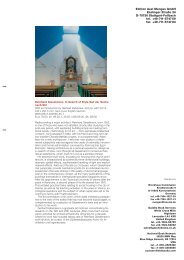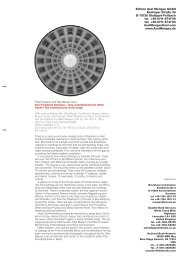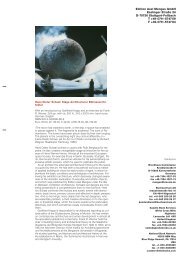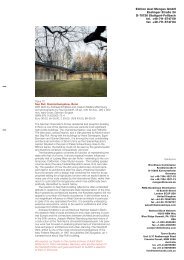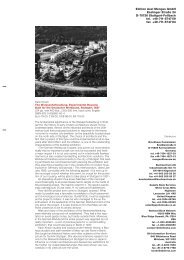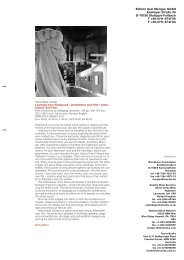Bruno Paul - Edition Axel Menges
Bruno Paul - Edition Axel Menges
Bruno Paul - Edition Axel Menges
You also want an ePaper? Increase the reach of your titles
YUMPU automatically turns print PDFs into web optimized ePapers that Google loves.
gate to the Bavarian parliament who denounced the pernicious influences of a versimplicissimusten<br />
Gesellschaft (Simplicissimusified society); in his diatribe he condemned at a single<br />
stroke progressive movements in literature, politics and art. 100 <strong>Paul</strong>’s 1905 illustration Streit der<br />
Moden (quarrel of the fashions) epitomized the attitudes of this Simplicissimusified society. 101<br />
»Above all the reform dress is hygienic, and keeps the body conditioned for the demands of<br />
motherhood«, read the caption, echoing the proponents of the simple, practical Reformkleid. »As<br />
long as you’re dressed in those rags«, came the reply, »you won’t have to worry about that particular<br />
embarrassment.« 102 Although <strong>Paul</strong> himself never designed a Reformkleid, by 1905 he had<br />
turned to the applied arts to extend this influence from the public realm of artistic expression to<br />
the private domain of daily life.<br />
<strong>Bruno</strong> <strong>Paul</strong> and the applied arts<br />
<strong>Paul</strong>’s engagement with Simplicissimus and the circle of progressive artists on its staff led directly<br />
to his career in the decorative arts, and to his participation in the development of the Kunstgewerbebewegung<br />
(applied arts movement). He apparently executed his first furniture designs for<br />
his colleague Heine in 1897. Heine had rented an apartment furnished in the heavy, historicist style<br />
favored in nineteenth-century Munich. Despairing of his landlord’s taste in decoration, he enlisted<br />
his friend and fellow Simplicissimus illustrator <strong>Paul</strong> to compose something more in keeping with<br />
the spirit of the times. Although there is no surviving evidence to corroborate this story, which<br />
<strong>Paul</strong> himself told in 1966, 103 he was already demonstrating the natural abilities that would foster<br />
his success as an architect and a decorative artist shortly after joining the staff of Simplicissimus.<br />
He soon found a client for his work in the Vereinigte Werkstätten für Kunst im Handwerk (united<br />
workshops for art in handicraft).<br />
The Vereinigte Werkstätten für Kunst im Handwerk was incorporated in Munich in 1898 by a<br />
group of artists who had participated in the »VII. Internationale Kunstausstellung im Königlichen<br />
Glaspalaste in München« (seventh international art exhibition in the royal glass palace in Munich),<br />
104 held in 1897. <strong>Paul</strong> was a member of the circle of progressive Munich artists who had exhibited<br />
at the seventh international exhibition, many of whom belonged to the Sezession. The<br />
Sezession fostered an atmosphere of artistic synthesis that inspired members such as Riemerschmid,<br />
Peter Behrens, and Adalbert Niemeyer to expand their work to include the design and<br />
production of furniture, metalwork, clothing, and other artifacts of modern life. The spirit of the<br />
Gesamtkunstwerk also pervaded the rooms devoted to the applied arts at the VII. Internationale<br />
Kunstausstellung. These rooms were among the most popular at the exhibition, and prompted<br />
such enthusiastic reviews as the article »Endlich ein Umschwung« (finally a change for the better)<br />
in the influential journal Deutsche Kunst und Dekoration. 105 The successful inclusion of the applied<br />
arts in the seventh international exhibition inspired the foundation of the Ausschuß für Kunst<br />
im Handwerk (the committee for artistry in craftsmanship) to promote the continued exhibition of<br />
decorative arts at the annual exhibitions of fine art. The very wording of its title, »Kunst im Handwerk«<br />
(artistry in craft), became a rallying cry for the Kunstgewerbebewegung, and a synopsis of<br />
its principal objective. 106 On 13 April 1898, its members incorporated the Vereinigte Werkstätten<br />
für Kunst im Handwerk G.m.b.H. in Munich. 107 The Vereinigte Werkstätten was dedicated to the<br />
development and promotion of the decorative arts through the manufacture and sale of artistdesigned<br />
housewares, a pragmatic recasting of the original ideals of the applied arts movement.<br />
Though <strong>Paul</strong> is frequently cited as one of the founders of the Vereinigte Werkstätten, 108 the documents<br />
of incorporation for the firm indicate otherwise. 109 Nevertheless, he was providing furniture<br />
designs for the company within a year of its establishment, and he quickly became one of its<br />
most prolific and successful designers.<br />
The Vereinigte Werkstätten manufactured the earliest documented furnishings and interiors designed<br />
by <strong>Paul</strong>. He must have demonstrated his abilities as a decorative artist prior to receiving<br />
his first commission from the Werkstätten, but his development as a designer paralleled the history<br />
of the firm. Initially he designed in the curvilinear Jugendstil vocabulary of the pieces he exhibited<br />
in 1897. 110 The vestibule that <strong>Paul</strong> designed for the »Kunst-Ausstellung Dresden« (Dresden<br />
art exhibition) of 1899 was typical of this early work.<br />
<strong>Paul</strong>’s work for the 1899 »Kunst-Ausstellung Dresden« illustrates the origins of his practice as<br />
an applied artist. The paneling, doorcases, and furniture were notable for the linear character of<br />
their ornamental embellishments. <strong>Paul</strong> used opulent and expensive materials in his design, including<br />
mahogany, brass, bookmatched black marble slabs, and yellow opalescent glazing. Yet he<br />
31. Room of applied arts at the »VII. internationale<br />
Kunstausstellung«, 1897. The room illustrated was<br />
furnished by the Ausschuß für Kunst im Handwerk.<br />
32. Vestibule exhibited at the »Kunst-Ausstellung<br />
Dresden«, 1899. Executed by the Vereinigte Werkstätten<br />
für Kunst im Handwerk.<br />
33, 34. Cover for Neue Grobheiten, 1903.<br />
employed these materials in a painterly manner, utilizing them to create a sumptuous visual experience<br />
without clear acknowledgement of their differing tectonic capabilities. The graphic quality<br />
of <strong>Paul</strong>’s vestibule was summarized in the frieze that he stenciled on the walls. The frieze was<br />
entirely two-dimensional, a direct translation of his printed work to an architectural scale. It was<br />
clearly related to his book illustrations for Albert Langen, such as his design for the back cover<br />
of Peter Schlemihl’s Neue Grobheiten. 111 <strong>Paul</strong> had never worked as a sculptor, and his room for<br />
the »Kunst-Ausstellung Dresden« lacked the plastic quality of contemporary works by Hermann<br />
Obrist or August Endell, who translated graphic conventions to three-dimensional forms. 112<br />
Yet <strong>Paul</strong> matured quickly as a designer. He continued to employ the fluid curvilinear forms of<br />
the Jugendstil, but he soon abandoned the applied decoration of his projects for the »Kunst-<br />
Ausstellung Dresden« in favor of an intrinsic, architectonic ornamentation. In the »Jagdzimmer«<br />
(hunter’s room) that he designed for the Vereinigte Werkstätten at the end of 1899 he exploited<br />
the ornamental qualities of a single material: elm wood. The room included elm paneling, carved<br />
elm reliefs, and elm chairs composed of simple members with dramatic compound curves that<br />
imparted a muscular vitality. His sparing use of accent materials, including gray-green upholstery<br />
and brass lamps, heightened the dramatic effect of the pronounced grain of the wood. The artistic<br />
quality of his hunter’s room was recognized at the »Exposition Universelle« of 1900 in Paris,<br />
where it received a Grand Prix. 113<br />
<strong>Paul</strong>’s »Jagdzimmer« epitomized his personal style at the turn of the century. The room was<br />
exhibited in Munich in 1901 at the »1. Ausstellung für Kunst im Handwerk«, the exhibition for<br />
which he designed the heron poster, and at the 1902 exhibition of decorative art in Turin. The armchairs<br />
for the hunter’s room, produced by the Vereinigte Werkstätten as Model 1744, were particularly<br />
successful. A set was sold to King Ferdinand of Bulgaria for installation in Sitnjakowo castle,<br />
<strong>Paul</strong>’s first royal commission. He continued to explore permutations of their characteristic splayed<br />
form, and produced a number of related designs between 1901 and 1904. The development of<br />
the Model 1744 armchair reflected the relentless experimentation that distinguished <strong>Paul</strong>’s work<br />
as a designer. Although he did not actually construct his furnishings with his own hands, in working<br />
through countless variations of his designs with the artisans who executed them he developed<br />
the profound and sympathetic understanding of form characteristic of a master craftsman.<br />
In 1904, <strong>Paul</strong> designed his »Herrenzimmer für den Regierungspräsidenten von Bayreuth« (office<br />
for the head of the provincial government at Bayreuth). The suite of furniture that <strong>Paul</strong> assembled<br />
included Modell 652 and Modell 2531 armchairs derived from the hunter’s room of 1899. In<br />
the Bayreuth office, however, these characteristically Jugendstil chairs served as a counterpoint<br />
to an interior dominated by straight lines and simple geometries similar to the motifs employed in<br />
the editorial offices that he designed for Simplicissimus in 1903. The editorial offices incorporated<br />
a frieze consisting of framed illustrations from the magazine that was echoed in horizontally<br />
striped walls and in the severe furnishings, another example of the influence of his graphic work<br />
on his projects as an applied artist. He developed the orthogonal motifs of his Simplicissimus office<br />
in his design for Bayreuth, evoking the final, rectilinear phase of the Jugendstil. The rectilinear<br />
aesthetic of the turn of the century originated with the arts and crafts movement, and received its<br />
canonical form in the works of the Scottish architect Charles Rennie Mackintosh and the Wiener<br />
Werkstätte of Vienna, established by Josef Hoffmann in 1903. Yet while <strong>Paul</strong>’s success as an applied<br />
artist paralleled that of Hoffmann, 114 there is little in his Bayreuth office to suggest the influence<br />
of Glasgow or Vienna. 115 Instead he drew his inspiration from German design of the late<br />
eighteenth century.<br />
Similarities between <strong>Bruno</strong> <strong>Paul</strong>’s designs and the simple, sturdy classicism of the Biedermeier<br />
period, the age of Goethe and Schiller, were the subject of critical comment even before he had<br />
fully forsaken the lingering influence of the Jugendstil. 116 Although later historians have tended to<br />
focus on the formal qualities of the German classicism of the early twentieth century, contemporary<br />
critics adopted a more nuanced assessment of the relevance of the Biedermeier to modern<br />
design. 117 A 1905 article by E. W. Bredt in Dekorative Kunst entitled »<strong>Bruno</strong> <strong>Paul</strong> – Biedermeier –<br />
Empire« included an evaluation of the influence of eighteenth-century precedents on <strong>Paul</strong>’s work.<br />
Bredt noted that the salons of the late eighteenth and early nineteenth centuries shared a fundamental<br />
characteristic of »simple, domestic elegance« with those designed by <strong>Paul</strong>. »When one<br />
examines black-and-white illustrations of <strong>Paul</strong>’s furniture and interiors«, he continued, »the effect<br />
of the surfaces and lines alone speaks of a certain coolness that is characteristic of design in the<br />
age of Napoleon, although the differing colors of woods, wall coverings and upholstery caution<br />
against too close a comparison of the old and the new designs.« 118 This description, which accords<br />
perfectly with tendencies that would coalesce in <strong>Paul</strong>’s work after 1908, was illustrated with<br />
24 25


